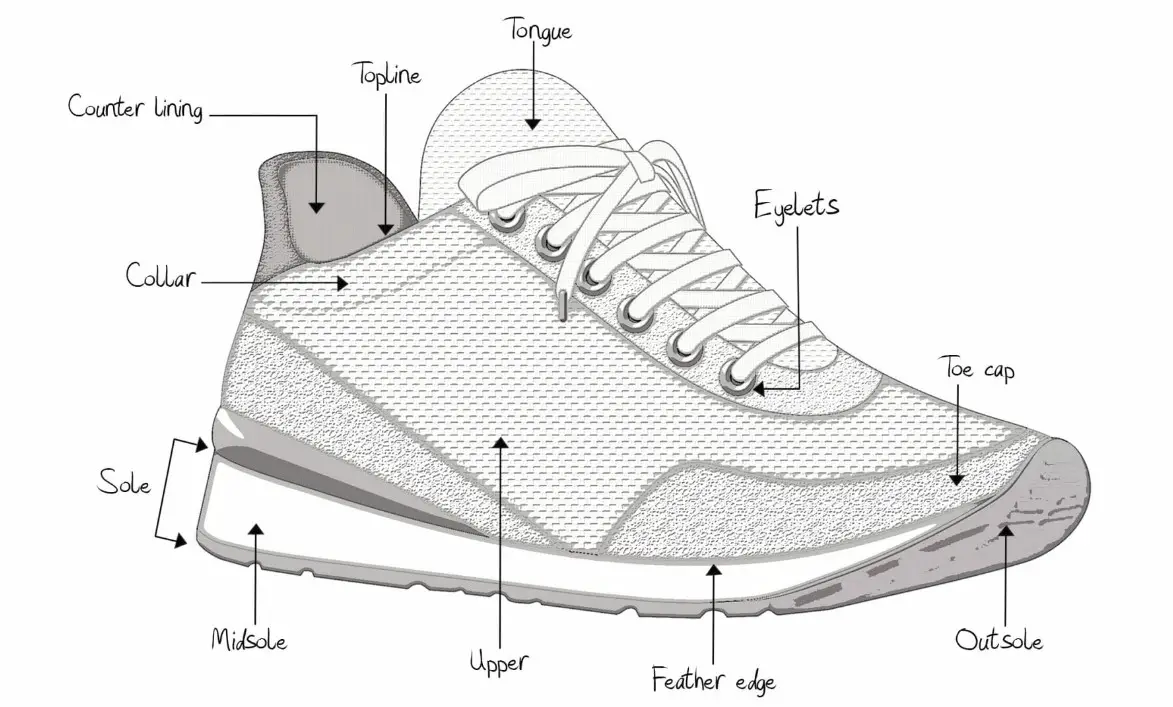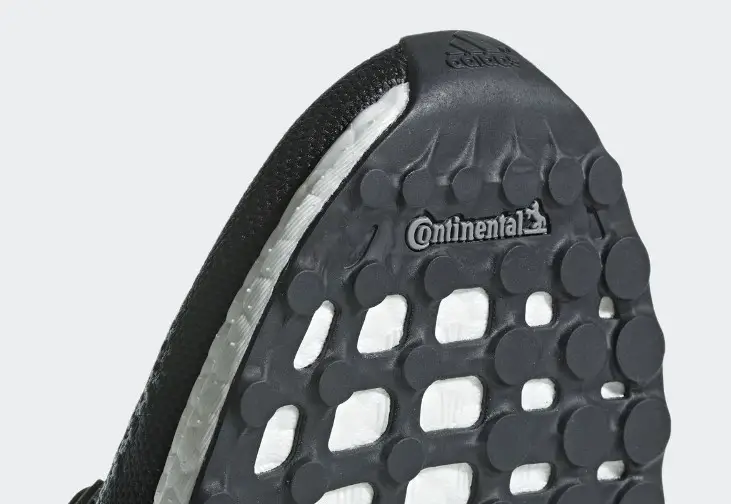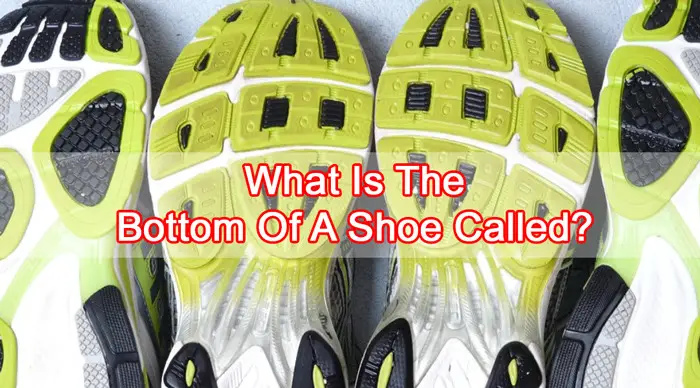Blog
What Is The Bottom Of A Shoe Called?
A pair of running shoes has many terms attached, corresponding to the parts and functions of the shoe. At its most basic, a shoe consists of the sole, toe, insole, and outsole that covers the foot.
So what is the bottom of a shoe called? Have you ever wondered about it? This article will cover all you need to know in detail about the terminology of shoe parts.
Contents
What Is The Bottom Of A Shoe Called?
The bottom of the shoe is called the sole, consisting of three main parts: insole, midsole, and outsole.
Because the outsole is the component that directly touches the hard ground, it is one of a shoe’s most valuable bottom parts.
Insole
The insole is located at the bottom of a shoe’s inside part. It mainly shapes the inner shoe form to fit the foot structure.
Thus, the insole significantly impacts the foot’s smoothness, comfort, and capacity for support. Depending on the insole’s substance, it also dehumidifies and deodorizes.

Midsole
Between the insole and the outsole lies the center portion of the sole, known as the midsole.
The primary functions of the midsole are to generate elastic smoothness when moving, sustain the force, decrease friction, and absorb dynamics.
In running shoes and sports shoes, the midsole is crucial.
Outsole
The shoe’s outsole is a layer of material that comes into direct contact with the ground.
The outsole of shoes comes in various forms and materials depending on the intended function and the terrain. It usually has traction and is made of rubber.

The heel is also called the sole.
However, the part of the heel that reaches the ground is long and thin, similar to a stiletto. It contacts the surface at the same time as the rest of the heel sole.
You’ll love: Why Do Basketball Players Wipe Their Shoes With Their Hands?
Other Parts Of A Shoe Bottom
The bottom of the shoes comprises various components in addition to the sole. The shoe bottom will contain several elements depending on the material and design of specific shoe designs, such as dress shoes, sneakers, high heels, and sandals.
Welt
On dress shoes, a welt is a strip of fabric stitched around the upper outsole, onto which the outer sole is attached.
It attaches the top to the sole better. Not all shoes have welts, although most more expensive and well-made shoes have.
Shank
The band dividing the outer and inner soles is known as the shank. It keeps the shape of your shoe and supports the foot.
The shank can be made out of leather or metal. It flexes to launch and catch your foot as you walk.
Heel
The outsole, which is separated into the heel and the tip, as was already explained, is another name for the heel. Nevertheless, the heel is often higher and thinner.
From the wearer’s perspective, this is one of the most crucial components of a shoe.
The seam where the stitching of the outer shell is positioned may be visible or concealed in the heel’s rubber and leather-stacked construction. Like the base of the shoe, it is always in touch with the ground.
The material at the heel is called foxing. If your shoes don’t fit properly, they will immediately begin to deteriorate as they cover the entire rear of the shoe. The heel counter, the stiffest component on the back of your shoe, is directly behind it. It aids in maintaining the contour of the shoe.
Heel Seat
Sandwiched between the heel and the upper is the apex of the heel. Many sneakers have them, however, not all shoes do.
Heel Cap
Women’s higher heel shoes, including block heels, stilettos, sandals, and slippers, all include a heel cap at the base.
Defending the heel’s bottom, the heel cap improves traction and stability.
Feather
The edge where the shoe upper and sole come together and are joined is known as the feather. It can be rounded, feathered, or have an advantage.
Main Parts Of A Shoe
Tongue
The shoe tongue is a length of cloth that hangs down from the vamp of some slip-on shoes and beneath the eyestays of lace-up shoes.
It is positioned on top of the foot to prevent lace rubbing across the front of the foot.
Mudguard
The mudguard, which wraps around the toes at the front and sides of a sneaker, is frequently constructed of a rigid material.
The mudguard protects your sneaker from severe damage, whether made of mesh, suede, or another extremely delicate textile.
Additionally, a good mudguard will stop water from entering your shoe through these more porous materials.
In contrast to the quarter and vamp of a sneaker, the overlay, foxing, and mudguard of a shoe are frequently made of contrasting colors and fabrics.
Overlay
The layer or layers of cloth that give the top its structure (note the black and blue lines) are frequently composed of reflecting materials for visibility.
It could have the logo’s form on them. To save weight, many shoes are doing away with overlays.
Shoelace
Shoelaces, often known as shoestrings, go through eyelets on the eye stay. They serve to secure the shoes to the feet.
Different materials are used to make shoelaces, including cotton, elastic, flat, and rounded materials.
Toe box (or toe cap)
A piece of material that covers the toe region of a shoe is called a toe cap. It comes in a variety of shapes.
It is frequently used to strengthen the toe region. However, it can often be just ornamental.
Vamp
The front portion of a shoe is referred to as the vamp. It is located in the upper’s front region, from the toe tip to the inner quarter (before the heel area).
The vamp and quarter of specific shoe designs are made of a single piece of material, whereas other shoe types are made of many sewn pieces.
Quarter
The quarter, which covers the sides and back of the foot, is another component of a sneaker’s top.
The quarter frequently matches the vamp’s material. However, it can also have a quarter overlay, commonly made of a different material, to improve the shoe’s overall design.
Typically, the rear portion of the upper starts where the vamp ends and wraps around the heel. The quarter and vamp will be made of the same material if the shoe is entirely cut. However, shoes are often made of two pieces of leather.
Collar
The shoe collar is the upper back and top of the quarter, where you place your foot. It is approved to support the ankle.
Where your foot goes into the quarter at its upper edge, this is frequently cushioned for enhanced comfort. That is the cloth your sock touches inside the sneaker, commonly called the lining.
To increase comfort, the sock liner of sneakers frequently includes cushioning.
Final Words
The fundamental components of a shoe are the sole, toe, insole, and outsole, which cover the foot. However, a shoe’s remaining components also include various extras.
The bottom part of the shoe is called the outsole, consisting of three main components: insole, midsole, and outsole. Depending on the shoe type, the shoe’s parts will be different.

